British Rail Class 47 facts for kids
Quick facts for kids Brush Type 4British Rail Class 47 |
|
 |
|
| Two Class 47s, Nos. 47424 and 47607, at Bangor station with a passenger train in 1987 | |
| Power type | Diesel-electric |
|---|---|
| Builder | Brush Traction and British Railways’ Crewe Works |
| Build date | 1963–1968 |
| Total production | 512 |
| Configuration | Co-Co |
| UIC classification | Co'Co' |
| Gauge | 4 ft 8 1⁄2 in (1,435 mm) |
| Wheel diameter | 3 ft 9 in (1.143 m) |
| Wheelbase | 51 ft 6 in (15.70 m) |
| Length | 63 ft 7 in (19.38 m) |
| Width | 8 ft 10 in (2.69 m) |
| Height | 12 ft 9+1⁄2 in (3.90 m) |
| Locomotive weight | 112 long tons (114 t) to 125 long tons (127 t) |
| Fuel capacity | 850 imp gal (3,900 L; 1,020 US gal) |
| Prime mover | Sulzer 12LDA28-C |
| Multiple working | Not fitted when built. Some now retrofitted with ● Green Circle |
| Top speed | 75 mph (121 km/h) or 100 mph (160 km/h) |
| Power output | Engine: originally 2,750 bhp (2,050 kW), later derated to 2,580 bhp (1,920 kW) |
| Tractive effort | Maximum: 55,000 lbf (245 kN) to 60,000 lbf (267 kN) |
| Train heating | 47/0: Steam generator 47/3: None 47/4: Electric Train Heat |
| Locomotive brakeforce | 61 long tons-force (608 kN) |
| Train brakes | Vacuum, Air, or dual |
| Career | British Railways |
| Number | D1500–D1999, D1100–D1111; later 47001–47981 |
| Axle load class | Route availability 6 or 7 |
The British Rail Class 47 is a famous type of diesel-electric train that was built in Britain. It was first called the Brush Type 4. These powerful trains were made by Brush Traction in the 1960s.
A huge number of them, 512 in total, were built between 1962 and 1968. This made them the most common type of mainline diesel train in Britain. They were built at Crewe Works and Brush's Falcon Works in Loughborough.
Class 47s have a special Sulzer 12-cylinder diesel engine. This engine gave them a lot of power, originally 2,750 bhp (2,050 kW). They were used for over 40 years on both passenger and freight trains across Britain. Even today, some are still running on main lines and special heritage railways.
Contents
What is a Class 47 Locomotive?
The Class 47 is a type of train that uses a diesel engine to create electricity. This electricity then powers motors that turn the wheels. This is why it's called a "diesel-electric" locomotive. They were designed to be strong and reliable. This made them very useful for many different jobs on the railway.
How Many Were Built?
Between 1962 and 1968, 512 of these locomotives were made. This was a huge number for a single type of train in Britain. Because so many were built, you could see them almost everywhere on the railway network. They became a very common sight.
What Were They Used For?
Class 47s were incredibly versatile. This means they could do many different things. They pulled long passenger trains, including important express services. They also hauled heavy freight trains, carrying goods all over the country. Their ability to handle both types of trains made them very valuable.
Their Long Service
These trains have been around for a long time. They started working in the 1960s and many are still in use today. Even with newer, more modern trains being introduced, the Class 47s have continued to prove their worth. Some are used for special trips on heritage railways, keeping railway history alive.
Images for kids
-
Class 47/3 47376 in Freightliner livery, at Toddington station
-
Class 47/4 47523 in standard BR Blue, at Birmingham New Street station in 1988
-
Class 47/7. 47787 parked in a bay platform at Rugby station
-
47817 in Virgin Trains livery at Exeter St David's station.
See also
 In Spanish: British Rail Clase 47 para niños
In Spanish: British Rail Clase 47 para niños












